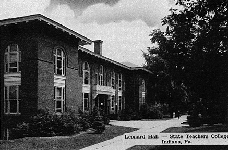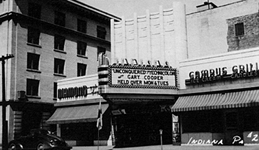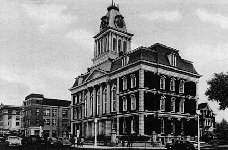'My People'
Edward Abbey's Appalachian Roots in Indiana County, Pennsylvania
by James M. Cahalan
Part II, Section 4 : IUP, Abbey's Indiana Novels, and Indiana People and Places
The caption to Abbey's photo in his senior yearbook, L'Indien, seems apt enough: "EDWARD ABBEY ... General College ... Dramatic and Speech Clubs ... hobbies are politics, writing, and hitch-hiking... favorite course is English."[44] Following graduation in 1945, he spent a couple of years in the Army in Italy. At one point, much to his surprise, he was visited there by his father, who had sailed to Europe on an epic post-war trip involving the shipment of horses to regions devastated by Hitler's forces. Then, in 1947, Abbey continued his education at IUP (then known as Indiana State Teachers College), where he took writing classes from English department chairman Rhodes Stabley and published his first adult short story "A Fugue in Time," a rather Joycean stream of consciousness experiment, in the 1948 compendium The Indiana Student Writes.
The FBI started its file on Abbey after he posted a letter against the draft at IUP. His two-year hitch in the Army had broadened his experience of the world, helped open up his personality, and increased his interest in political issues. He seems to have continued to come out of his shell at IUP, as his classmate and friend John Watta remembers:
All of a sudden Ed Abbey came there in a blue workshirt, no necktie, jeans when it wasn't fashionable. And you'd swear he'd just walked in off of the farm and he didn't give a damn. There'd be a bunch of guys standing around talking, and Ed would sort of edge up to the back and, eventually; he'd squeeze himself into the front and before very long people were listening to Ed. There were some really hot discussions out there. I loved to be outside Leonard Hall in those days because they would almost lead to fisticuffs in many cases. A lot of them were returning GIs, like I was, and a lot older than the average college freshman. Of course, Ed was too.
The original Leonard Hall in Abbey's days on the Indiana campus was the home of the English Department. It was replaced by a new hall after burning down in 1952. Adds Sam Furgiuele, another classmate and veteran: "Ed was a teaser. He said a lot of things tongue in cheek. He would say things, I think, to get a reaction. And he would upset people." Abbey and his friends frequented such downtown Indiana places as the Campus Grill and the Indiana Theatre.
Later, in his journal, Abbey would recall "Indiana, Pa.: campaigning at Teachers College I admitted that Wallace might not win but confidently asserted that at least he would get more votes than Truman. Nasty argument with old English teacher Nicholson."[45] Art Nicholson had been one of Abbey's teachers at Indiana High School, and in 1954 he reviewed Abbey's first novel, Jonathan Troy, in the Indiana Gazette: "The fact that the author found much of his material in this area may add something to the book for the local reader. Or it might cause dismay. Reactions should be interesting."[46] Nicholson's instinct was right. Nancy Abbey remembers that in Indiana "a lot of people were very upset" by Jonathan Troy. Ed Abbey, while crediting the publication of the novel with giving him encouragement to continue his career as a writer, came to despise it. But "at the same time it's here," as John Watta notes, as a record of life in Indiana, Pennsylvania, in the middle of this century. "I loved that because he talks about the way adolecents behave -- and this area in particular."
Jonathan Troy is Abbey's only book set entirely in Indiana, which is only very thinly disguised as "Powhatan"; Abbey generally preferred specific Native American names to the generalized, Anglo-imposed "Indiana." In his journal, Abbey drew a map of Powhatan and the places in his novel, many of whose names were those of actual Indiana businesses in the 1940s, when he was in high school. Jonathan Troy and his father live in an apartment above the Blue Bell Bar (modelled on the Blue Star Restaurant), and Jonathan looks out his window and sees, among other places, such actual Indiana establishments of the period as the "Hotel Moore," "Ford Sales and Service," the "Dairy Dell," and "G. C. Murphy's Five and Ten."[47] Abbey describes the Dairy Dell with particular fondness: "They wheeled into the cool darkness of the drugstore and sat down on the red stools by the yellow-stained marble counter. The Fountain" (26). We read that "The lights went out over the Dairy Dell ... over Anderson's Shoe Store and Stewart's Hardware and B. G. Troutman's Department Store and Henry Howell's Bookstore" (123), with Abbey oddly changing the real "Henry Hall" to "Henry Howell" while leaving the others unchanged. He also interspersed newspaper clippings in the novel -- containing listings, for example, of a meeting at "the Powhatan American Legion Home" with "an interesting talk by Mr. J. V Bradford, feature editor of the Powhatan Gazette, on the topic 'Is Communism Infiltrating Our Schools?"' (60)
Some Downtown Indiana Places of the 1940s
- Stewart's Hardware Store, owned by Jimmy Stewart's father (now S & T Bank)
- The Moore Hotel (R. B. Shannon and Associates today)
- Henry Hall's stationery store
- G. C. Murphy's Five-and-Ten store (now the Atrium complex)
- The Dairy Dell (now Culpepper's bar)
- Indiana Theatre
- The Plaza poolroom, below the theatre
- The Campus Grill
- Anderson's Shoes (now American General Finance)
- Ford Sales and Service (now a parking lot)
- Waxler's Department Store (now First Commonwealth Trust)
- The old Indiana Country courthouse (now National Bank of the Commonwealth)
- The Blue Star Restaurant (now the Coventry Inn)
- The Ritz (later Manos) Theatre (now Indiana County Head Start)
- The American Legion
In Jonathan Troy, Abbey took many more liberties with his own family life than with the geography of Indiana and the outlying countryside. Jonathan's mother is dead, and he shares an apartment in town with his father, who leads a labor demonstration at "McGlauflin's Tire and Rubber Works" (McCreary's, in real life); none of these particulars were true of Abbey and his parents. But Jonathan does think back to another home and an earlier life in the countryside, which were the Abbeys' actual ones: "way up the hollow in the vine-covered hills ... the old farm which nobody wanted any more and which nearly everybody had forgotten except the boy" (243). And Abbey introduces a character who recurs much later in The Fool's Progress: Red Ginter, who ambushed Jonathan at his school bus stop and chased him, as Jonathan remembers in a flashback. Earl "Red" Ginter was the name of an actual classmate at Rayne Township Consolidated School who was several years older than Ed but was always far behind his age group in school.
Ed Mears tells the story of how Red Ginter and his family died in a fire at their house in 1982: they got out safely at first, but then went back in to try to retrieve all of their money which they had stored in tin cans. Mears' account of an earlier attempt by the Ginters to bury their beloved family horse is almost Faulkneresque. They couldn't get the hole wide enough to fit the horse, its legs fully extended in rigor mortis. Mears stopped by and suggested that they cut the legs off, but they'd hear nothing of that. So he had to go get a big farm machine and force the horse into its grave.
Abbey apparently combined Red Ginter with Red Hankinson, who "lived in Chambersville," according to Howard Abbey, "a great big guy three or four years older than we were. He had the great sport of beating up on little kids." The Fool's Progress describes an unforgettable boyhood baseball game that ends when Red Ginter hits a home run but refuses to run the bases. This later, greater novel also contains a great many other actual Indiana County family names. Henry Lightcap sees the names on markers in the graveyard, as if Abbey were making sure to memorialize "the Hintons, the Fettermans, the Lingenfelters, ... the Gatlins, ... the Taits, the Ginters, the Adamses," before he arrives "at the site reserved for Lightcaps" (320).
In April 1986, Abbey took a road trip home to research places for The Fool's Progress, taking notes on Sutton, West Virginia, as a model for the book's principal town of Shawnee. For example, he copied down names from the Sutton war memorials for use in the novel, when Henry Lightcap walks past such memorials (497-98). However, in the typescript of the novel, Abbey crossed out some of the names he had copied down in Sutton and substituted several he had known growing up in Home and Tanoma: Fetterman, Ginter, and Tait, for example.[48] Such was his attachment to his native place.
Next section: Abbey's Visits Home
Notes
[44] My thanks go to Evelyn Booth, secretary at the Historical and Genealogical Societyof Indiana County and a contemporary of Abbey at Indiana High School, for locating and copying this item for me.
[45] Abbey journal entry of 3 Sept. 1956, Abbey collection, box 4, folder 6.
[46] Nicholson, "Indiana High Grad, Ed Abbey Turns Novelist; Authors 'Jonathan Troy'," Indiana Gazette, 3 March 1954, n. p.
[47] Abbey, Jonathan Troy (New York, 1954), 264.
[48] Abbey collection, box 15, folder 1, 880. Bill Abbey reports (in a letter to me of 19 April 1996) that the use of the name "Tait" was his brother's disguised tribute to Chuck Streams, son of Tait Streams, the Abbeys' next-door neighbors when they lived in Home. A great athlete and a couple of years older than Ed, Chuck Streams was killed in pilot-training in Texas at the end of World War II, shaking up the Abbeys and the whole town of Home. The "best player and one genuine athlete" on Henry Lightcap's baseball team is Chuck Tait (Fool's Progress, 86).
Why ads for Amazon?



